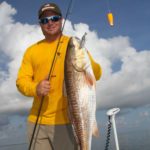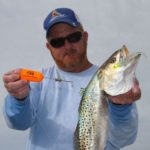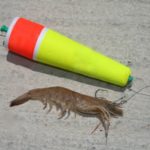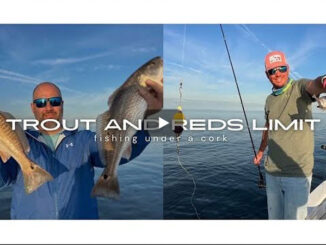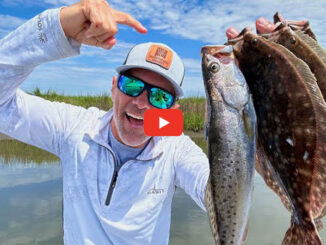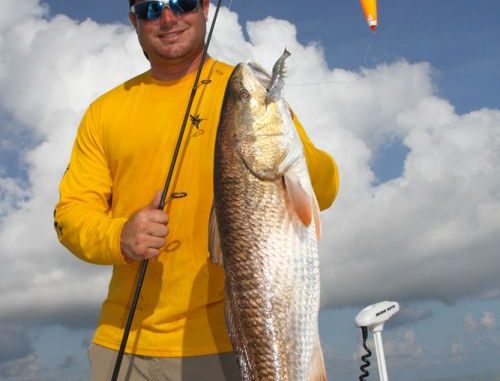
Get the most pop out of your corks by employing these guides’ tactics when targeting specks and reds.
Sometimes it’s the noise, other times it’s the approach. Either way, popping cork rigs are a must-have tool for your inshore arsenal.
“It’s the top way to catch fish because it’s universal,” said Capt. Cody Obiol, who guides out of Cajun Fishing Adventures in Buras. “There’s a certain time to catch redfish on spinnerbaits, and a certain time to catch redfish on the bottom. Other than the really cold months, corks are pretty much year-round.”
The traditional popping cork comprises a cone-shaped float with a broader, concave top and a removable plastic pin to cinch your line against the inner core. Place the cork 2 to 3 feet above your bait, chug the float with sharp rod snaps and creates a gurgling commotion that predators assume is another fish feeding, or perhaps a prey item splashing at the surface.
When that trout or redfish comes to investigate the activity, they find a vulnerable offering suspended below. Each time you chug that cork, the bait rises and falls in a tantalizing display.
Traditional popping corks still retain their relevance, but the contemporary scene belongs to the clacking cork rig, which comprises a wire stem with a sliding float flanked by noisy beads and swivels at each end. Tie your main line to the top swivel and a leader to the lower position, and you have one of the most user-friendly rigs in saltwater fishing.
Also user-friendly is the assortment of color options, like neon green, orange, yellow and pink. Fish don’t seem to show any preference, as their attention usually goes to the bait or lure dangling below. But for anglers — charter boats, or a handful or fishing buds — varying cork colors help everyone keep track of their position. Not only does this hasten strike response, but aids in minimizing inadvertent line crossing.
Bait options
When it comes to bait, cork rigs don’t discriminate — everybody’s welcome at this fish-finding fais do-do. If you like natural bait, that means anything from live shrimp, croakers, finger mullet or cocahoe minnows; to cut mullet or pogy. The real stuff is an easy way to keep kids or novices in the game, as you just tug every now and then, watch the cork and when it disappears, start reelin’.
Experienced anglers tend to favor artificials for several reasons:
Low maintenance — Natural baits are subject to the appetites of trash fish like jacks and catfish; while overzealous casts can simply rip your hook from the bait.
Longevity — Even if you keep that bait on the hook, if predators are slow to respond, that natural deal will eventually become limp and washed out. Not so with plastic and metal.
Efficiency — The softer nature of natural bait requires a slower, even stationary presentation, while artificials allow you to step on the gas and cover water.
Anglers typically find artificial shrimp like the original DOA, LIVE TARGET’s Rigged Shrimp, Egret Baits’ Vudu Shrimp and Z-Man EZ ShrimpZ are a popular choice for trout and redfish. Obiol agrees, but he prefers a ¼-ounce jighead with a variety of baits selected to match the scenario.
“I like putting the baits that I choose on the hook because it makes it easier to change baits when you have to,” he said. “If you put a (pre-rigged) shrimp on there and you cut it off twice, you have to tie a whole new leader. But if you put a jighead on there, you can change baits all day and not have to worry about it.”
Rig it right
Braided main line is the way to go for longer casts, optimal popping response and immediate strike response. However, braid has it’s downside — and Obiol adds an extra rigging step to prevent headaches.
“I like to put a 6-inch piece of monofilament tied straight to the braid and the other end tied to the cork rig,” he said. “That keeps the bottom of the cork from wrapping in the braid. That braid’s really flimsy, it doesn’t have much stability, so you need that (stiffer) monofilament to keep from wrapping up your corks.”
Below the cork, Obiol likes a standard 18-inch leader of 30-pound fluorocarbon. Those jigs and synthetic shrimp are usually heavy enough to straighten out the leader on your cast and pull it straight after the pop. For natural baits, especially lighter shrimp, a split shot about 6 inches above the hook will help.
For deep spots a traditional popping cork below a bead and a bobber stop allows you to target deeper spots. Here the surface commotion become less important, but that hopping motion can still generate interest.
“If you’re in 18 feet of water, you set your bobber stop at 16,” Obiol said. “That way, you’re hanging off the bottom and you’re not snagging anything.”
When and where
Aside from sight-fishing reds in clear marsh pockets or targeting tailers, there aren’t many wrong times to fish a popping cork in coastal waters. However, there are times when this tool proves especially helpful.
The last two hours of an incoming tide provide a good mix of trout along the marsh perimeters along with redfish, which patrol the grass edges for crabs and other crustaceans. When the tide turns, the first two hours of the outgoing tide is when you want to target the mouths of marsh drains where redfish capitalize on easy meals.
Elsewhere, Obiol appreciates how the cork rig allows him to fish over oyster reefs and isolated patches of shell bottom extending from marsh shorelines. He’ll also work cuts between grass points and gaps in roseau cane lines, where flowing water creates feeding opportunities. In these current scenarios, the popping cork rig serves as much a positioning aid as a fish attractor.
“The fish may not want something landing right on top of them, so you want to throw the cork to keep your bait off the bottom while it drifts to the fish,” he said. “When you’re fishing a cut that’s draining water or water’s going in, you want the cork to cover as much ground as possible. You let the cork drift along the shoreline or go in the cut and come out, so it looks natural.
“If you throw a cork, your bait’s always going to go with the current, whereas, if you’re pulling a jighead and you have to move it a certain direction, you might be pulling it against the current. Fish see that this bait is going the opposite way than all the rest of them.”
Cast and cadence
Popping cork anglers do best with a 7- to 7 ½-foot medium-heavy spinning outfit. Benefits include greater casting distance, and greater back-cast clearance with the cumbersome rig. (Essentially, long rods help prevent accidental snagging and entanglements.)
It’s important to properly equip yourself, as the popping cork presents a challenge uncommon to baits tied directly to your line. It’s all about the physical dynamics of a two-sectioned rig — the first where the main line meets the cork; the second where the baited leader attaches underneath.
While we typically whip a lure or baited hook backward to load the rod — and then snap the rod forward to direct that kinetic energy — popping cork rigs require a more measured action. Your best bet is to bring the rod tip backward in a slower version of the traditional back cast and pause. Look behind you to confirm clearance and then launch the rig forward in a controlled lob.
It might feel awkward and mechanical at first, but with practice, the operation becomes fluid and effective. Master this move, and the cool part — the popping and fish fighting — will be a breeze.
